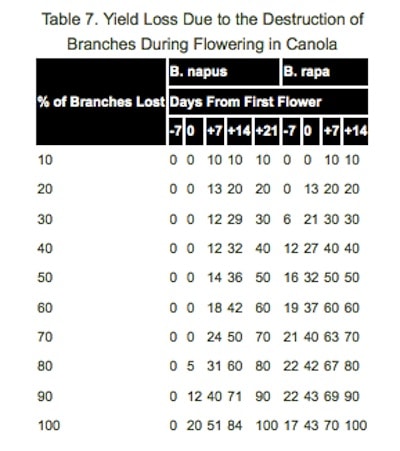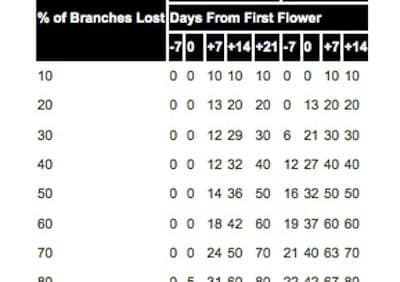
Canola is quite resilient to light hail at up to 20% flower. The crop can flower longer to compensate, and may recover with only minimal to moderate yield loss. Canola has also shown remarkable recovery from more intense hail at 20% flower. However, a crop flattened by hail is unlikely to recover. If regrowth occurs, which is possible, plants are set back so far that maturity becomes a major factor.
Canola hit by hail at late flowering is less able to compensate, as the flowering period is winding down and pod set is nearly complete. Look at the table and check the columns for 14 and 21 days after the start of flowering.
Hail and sclerotinia stem rot. Regrowth after hail may extend the flowering period, which also increases the sclerotinia stem rot risk. When hail hits at late flowering, broken stems and leaves along with lodging can further increase the sclerotinia risk due to the fungus growing from plant to plant directly. If flowering begins again after hail, growers may see a benefit from spraying for sclerotinia again if yield potential is above 25-30 bushels per acre, and conditions are moist (rain, humidity and/or dew). Keep in mind that some fungicides are registered for only one application per year. If you already sprayed a product with a one-application restriction, switch to a different one.
Hail and other diseases. Hail damage also allows a point of entry for diseases such as alternaria black spot and blackleg. Hail damaged tissue is aggressively colonized by various saprophytic organisms, which may limit any impact from blackleg and other plant pathogens. Hail can give blackleg an avenue of entry, but if the hail damage occurs well past the stage (4-6 leaf) at which blackleg infection can cause significant yield loss, its impact will be minimal. Fungicides may help reduce the development of these disease infections, but may not provide an economic benefit, and they do not cure disease-affected or hail damaged plant tissue. Before investing more in the crop, consider the possible impact of delayed maturity, as fall frost damage could negate the potential benefits of the fungicide application. Finally, always leave check strips or areas so that you can judge the effectiveness of the fungicide application.
“Rescue” treatments. Nutrient and fungicide top dress treatments have been promoted to help heal and restart canola after hail. If applying crop enhancement products such as fertilizer and micronutrient blends on hail-damaged crops, keep in mind that there is very little research available on the efficacy of such products under these extreme conditions. It’s buyer beware. Leave a check strip to see if they improved yield.

